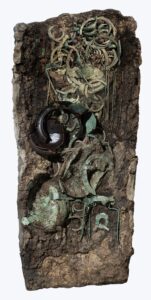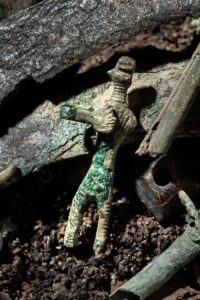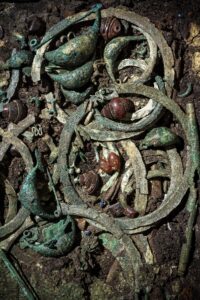A city as built up and continuously populated as Rome hides its most ancient secrets well, and there is almost nothing from the period around the traditional founding of the city (April 21st, 753 B.C.) to be seen in its famous archaeological sites and museums. As of this month, that is no longer the case. The Roman National Museum is opening a gallery dedicated to exhibiting funerary objects from Rome’s earliest years that have spent decades unseen in the stores of the Baths of Diocletian.
 The exhibition is the culmination of a two-year program focused on stabilizing, cataloguing, analyzing and restoring objects and remains unearthed from the large 8th-7th century B.C. necropolis on the Via Laurentina, the ancient road that connected Rome to Lavinium, near the medieval Castello di Decima. The site has been excavated since 1971 and hundreds of graves have been discovered. Perhaps the most archaeologically significant of them, Tomb 359, was discovered in 1991, removed in a soil block and then locked up in a wooden case for decades.
The exhibition is the culmination of a two-year program focused on stabilizing, cataloguing, analyzing and restoring objects and remains unearthed from the large 8th-7th century B.C. necropolis on the Via Laurentina, the ancient road that connected Rome to Lavinium, near the medieval Castello di Decima. The site has been excavated since 1971 and hundreds of graves have been discovered. Perhaps the most archaeologically significant of them, Tomb 359, was discovered in 1991, removed in a soil block and then locked up in a wooden case for decades.
Tomb 359 was exceptional for the number of luxury artifacts in the grave and for its unique deposition inside the trunk of a tree. That is why archaeologists removed it whole, to conserve its precious context, rather than excavating it in situ. The soil block would not be excavated for another 30 years.
Finally in 2021, Tomb 359 was cleared and conserved. The two-year process revealed the presence of human remains, previously believed to have decomposed in the soil. They belonged to a young woman who died around 730 B.C. when she was between the ages of 18 and 24. She and Rome were born, therefore, at the same time.
![]() She was buried in a garment festooned with jewels: a necklace of bronze pendants shaped like animals and humans, large rings attached to the gown with bronze and amber brooches, silver hair ornaments and more. A full banquet service with sacrificial knives, skewers for cooking meat, bronze and ceramic drinking vessels was also interred with her. There are objects of Etruscan and southern Italian origin in the grave goods. The amber in her brooch was imported from the Baltic Sea.
She was buried in a garment festooned with jewels: a necklace of bronze pendants shaped like animals and humans, large rings attached to the gown with bronze and amber brooches, silver hair ornaments and more. A full banquet service with sacrificial knives, skewers for cooking meat, bronze and ceramic drinking vessels was also interred with her. There are objects of Etruscan and southern Italian origin in the grave goods. The amber in her brooch was imported from the Baltic Sea.
The contents of Tomb 359 and other artifacts from Rome’s first two centuries will be on display at the Baths of Diocletian through September 3rd of this year.

